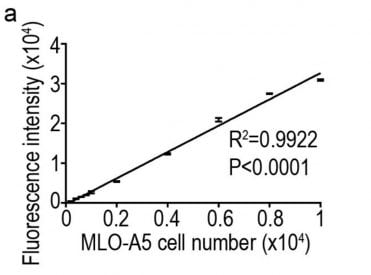Content #1
Content #1
Content #1
Bone cells such as osteoblasts or osteocytes can be difficult to count because they produce a mineralized extracellular matrix in culture. This matrix makes the cells difficult to dissociate, which is problematic for flow cytometric methods. In addition, the minerals deposited in the matrix exhibit green autofluorescence which makes it inadvisable to use green fluorescent dyes for cell quantitation. In a recent issue of Methods and Protocols, authors Yang et. al. describe a method to accurately count osteoblast cells using the red fluorescent nuclear stain GelRed®.
Using the murine MLO-A5 and IDG-SW3 osteoblast-like cell lines as well as human NHBC primary osteoblasts, cell lysates were prepared and mixed with the DNA-binding dye GelRed®, and then fluorescence was measured in a plate reader. They demonstrate that each of these cell types display good linearity between GelRed® fluorescence and cell number, even in the presence of mineral deposits or cells expressing GFP.
GelRed® is an ultra-sensitive and safe DNA gel stain. Learn more about the many uses for GelRed®.
